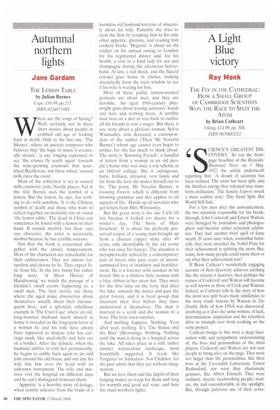A Light Blue victory
Ray Monk
THE FLY IN THE CATHEDRAL: How A SMALL GROUP OF CAMBRIDGE SCIENTISTS WON THE RACE TO SPLIT THE ATOM by Brian Cathcart Viking, £14.99, pp. 308, ISBN 0670883212 SCIENCE'S GREATEST DISCOVERY.' So ran the frontpage headline of the Reynolds' Illustrated News on I May, 1932, the article underneath reporting that: 'A dream of scientists has been realised. The atom has been split, and the limitless energy thus released may transform civilisation.' The Sunday Express struck a more sombre note: 'The Atom Split. But World Still Safe.'
For a few days after this announcement, the two scientists responsible for the breakthrough, John Cockcroft and Ernest Walton, were besieged by journalists and photographers and became rather reluctant celebrities. They had another brief spell of fame nearly 20 years later when, somewhat belatedly, they were awarded the Nobel Prize for their achievement in splitting the atom. But, today, how many people could name them or say what their achievement was?
If Brian Cathcart's wonderfully engaging account of their discovery achieves anything like the success it deserves, then perhaps the names of Cockcroft and Walton will become as well known as those of Crick and Watson. Indeed, as Cathcart tells it, the story of how the atom was split bears many similarities to the story made famous by Watson in The Double Helix of how DNA was discovered, involving as it does the same mixture of luck, determination, inspiration and the relentless drive to triumph over rivals working on the same project.
Cathcart brings to this story a deep fascination with, and sympathetic understanding of, the lives and personalities of the main players. Cockcroft and Walton are not easy people to bring alive on the page. They were not larger than life personalities, like their boss at the Cavendish Laboratory, Ernest Rutherford, nor were they charismatic geniuses, like Albert Einstein. They were ordinary, decent, hardworking people: modest, shy and uncomfortable in the spotlight. But, through judicious use of their corre spondence and the memories of those who knew them, Cathcart succeeds in involving us both in their scientific preoccupations and in their personal relationships.
Despite his lack of scientific training (he cheerfully announces in the foreword that he has never had a physics lesson in his life), Cathcart does an excellent job of placing the achievement of Cockcroft and Walton in its cultural and scientific context. Appropriately, he begins his story in Manchester in 1909, when Rutherford first discovered the atomic nucleus. Until then, it was believed that atoms were units of matter in which the mass was distributed more or less uniformly. Rutherford showed that, on the contrary, the bulk of the atomic mass was concentrated in a tiny nucleus that was, in relation to the size of the atom, like a 'fly in a cathedral'. The big problem that remained — the problem to which Rutherford dedicated his own career and the attention of his colleagues and students at the Cavendish Laboratory — was to investigate the nature of the nucleus itself. And that meant taking the nucleus apart to see what it was made of, just as one might take a watch apart to see how it works.
The attempt to understand the nucleus involved not only ingenious experimentation of the kind at which Rutherford and the Cavendish excelled, but also the bold theorising of the founding fathers of quantum mechanics, Bohr, Heisenberg, Born and Dirac, and Cathcart describes both with great expository and narrative skill. He is especially good at conveying the excitement and the frustrations Cockcroft and Walton experienced in putting together their particle accelerator, which. Cathcart emphasises, was an amateurish affair compared to its American rivals'. Where the Americans were achieving energies of over a million volts, Cockcroft and Walton could manage 'only' a few hundred thousand. As it turned out, however — and as predicted by quantum theory — one did not need a million volts to split an atom. In their pathbreaking experiment, Cockcroft and Walton split the lithium nucleus to form two helium nuclei, using just 125,000 volts. As the helium nuclei were being hurled out of the lithium with an energy of about 8 million volts, one gets a vivid sense, both of how much energy is released by atomic disintegration and of the full impact of Einstein's famous equation, E=mc2 (the truth of which received its first experimental confirmation with Cockcroft and Walton's discovery).
To describe the history of quantum physics in a readable and intelligible manner is no easy task. To combine that with a detailed and utterly engrossing account of one particular epochal experimental project, an account which gives us an insight both into how scientific advances are made and into the personalities of the people who make them, is a very fine achievement. I recommend Cathcart's book to anyone seeking an accessible introduction to one of the most exciting periods of scientific advance in the history of human thought.



































































 Previous page
Previous page